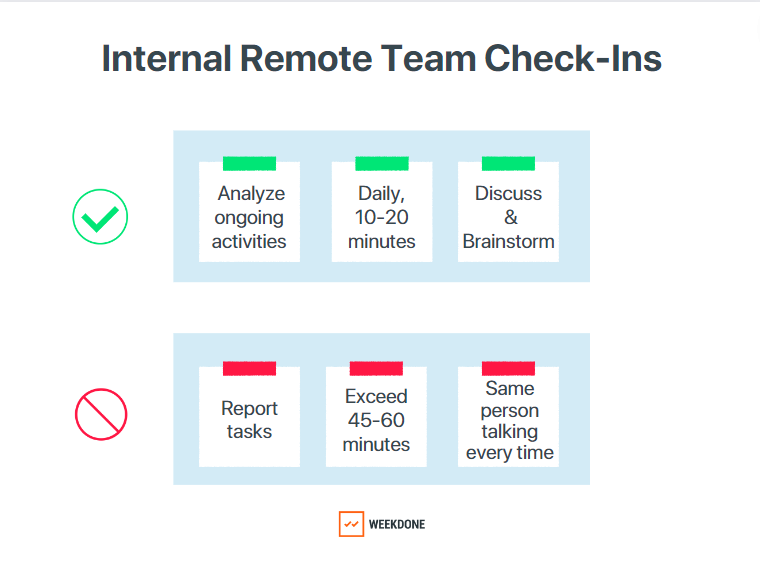What is the easiest way to ensure ongoing alignment? We believe that it is not about having more meetings but rather about having better ones.
In this article, we will cover what format for check-ins and OKR meetings work best for small and medium-sized businesses. At Weekdone, we are following this structure ourselves, and our customers, too, find it extremely easy to follow on an ongoing basis.
Internal check-ins for remote teams
If you are working remotely, you should have daily 10 to 20-minute check-ins within your own team (2-10 people). During this session, look at KPIs and discuss ongoing projects (initiatives) or ideas.
You should not report tasks during this meeting but rather look at your ongoing activity critically: how many customer interactions you have, which questions customers asked, and how can you reply better.
You can also discuss how you can be more helpful to other teams. If someone brings up a challenge or an idea that is worth exploring, you can spend more time talking about it – exchanging opinions. This is almost never pre-planned and should feel very new each time, so you will never be bored in a meeting.
No matter what you do, never have meetings longer than 45-60 minutes. So even if you have a very exciting discussion and you reach 60 minutes, everyone should just abruptly stop and say goodbye. You can continue thinking about it and bring it up next time but the meeting duration rule cannot be broken.
Even if you stop the conversation mid-sentence, it will only be a good thing. It becomes a cliffhanger like at the end of a TV episode and you want to come back and continue watching when the next episode comes out. Just remember, rarely anything good comes out of long meetings. They only lead to gradual demotivation and exhaustion, and those things add up.
2 types of cross-functional OKR check-ins
Cross-functionally, you should have 2 types of meetings: execution meeting and OKR progress update meeting.
1. Execution meeting (sprint planning)
This meeting should happen every 1st, 3rd, 5th, 7th, 9th, 11th, 13th week of the quarter. That is because you will have a different type of meeting every second week during the quarter.
During the execution meeting, you present what you commit to delivering within the next 2 weeks: make it the top 3 big priorities, both OKR-related and not. The next time you have this meeting (in 2 weeks), you will go over whether or not you delivered on our promises and present your plans for the next 2 weeks. If you are already doing sprint planning, this should sound very similar to you.
“This format taught us to be realistic about our commitment but it also helps to keep everyone accountable. When you say you’re going to do something and then show up 2 weeks later with empty hands, you feel disappointed so you will make the effort to avoid it the next time”.
Ana Kuchynska, Customer Success Manager at Weekdone
You should really do this bi-weekly meeting cross-functionally: have representatives from all teams get together and present what their teams are working on.
For example, you can have 2 people from Sales, 2 from Customer Service, 3 from Product Development, and 3 from Marketing. Once per month, you should also invite other people to listen in, just to stay in the loop. Sometimes the whole company could be listening in but the speakers will stay the same.
2. OKR progress update meeting
This meeting should happen every 2nd, 4th, 6th, … week of the quarter (every second week) on the same day and at the same time when you have your executions meetings on other weeks.
So you keep the same time but change the agenda.
OKR progress meeting has the same participants as the execution meeting but you don’t talk about deliverables in detail during this session. You should look at your OKRs in Weekdone and present the comments you left there (explaining the current situation – either how the progress happened or why there is no progress).
For both of these types of meetings you should also have an agenda point like “Any other topic you’d like to put forward”. If there is something like that to discuss, you need to add it to the agenda before the meeting. And it can never be more than 3 things at once.
Having different types of agendas helps you keep things fresh.
The formula for quarterly OKR meetings
This is the foundation – the basic fundamentals. What works for us at Weekdone, may evolve into something slightly different in your company and teams. But ultimately, the consistency and intention should remain.
At Weekdone, we offer OKR training opportunities to our customers – we’re ready to help make your meetings a success.
Not yet using OKR software? Book a demo to see, learn and ask questions from our experts. Find out how Weekdone can work in your company and teams.

